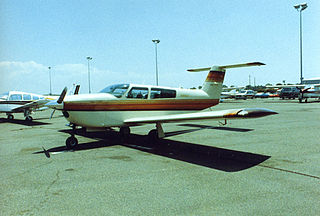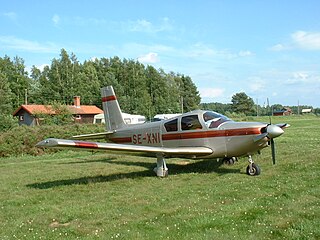Related Research Articles

The Bede BD-5 Micro is a series of small, single-seat homebuilt aircraft created in the late 1960s by US aircraft designer Jim Bede and introduced to the market primarily in kit form by the now-defunct Bede Aircraft Corporation in the early 1970s.
The Bede BD-1 was a two-seat, single-engine, low-wing monoplane, the first design of American aeronautical engineer Jim Bede. The BD-1 was designed in 1960 as a kit-built aircraft intended for home assembly by amateur builders. Design goals included a kit price of $US 2500, including a rebuilt 100 hp (75 kW) engine and a cruise speed of 130 knots (240 km/h). The prototype N624BD first flew in 1962.

The Schleicher ASW 15 is a single-seat sailplane designed in 1968 by Gerhard Waibel and manufactured by Alexander Schleicher GmbH & Co. The ASW 15 has shoulder-mounted wings and an all-flying tailplane, with its single tow-release placement a compromise between winching and aerotowing. The later ASW 15B had several improvements, including a tow-release placed on the plane of symmetry, an 11 cm taller rudder, a slightly larger main wheel, and the provision of a 90-litre water ballast system.
The Arado W 2 was a two-seat twin-engine seaplane trainer developed for the DVS in 1928. It was a cantilever monoplane with a fabric-covered steel tube fuselage that accommodated the pilot and instructor in tandem open cockpits. The undercarriage consisted of two pontoons carried on steel struts.

The Bede BD-4 is an American light aircraft, designed by Jim Bede for homebuilding and available since 1968. It was one of the first homebuilt aircraft to be offered in kit form. It remains one of the world's most popular homebuilts with thousands of plans sold and hundreds of examples completed to date.
The Bede BD-6 is a single-seat light aircraft first flown in the United States in 1974. Similar in design to the Bede BD-4, it is a high-wing cantilever monoplane of conventional configuration. The BD-6 is marketed as a kit homebuilt.
The Bede BD-8 was an aerobatics aircraft developed in the United States in the mid-1970s. It was a low-wing, single-seat monoplane of conventional configuration, albeit very short-coupled, and of all-metal construction. The single prototype was under construction by Jim Bede when his company, Bede Aircraft, faced bankruptcy in 1977. The incomplete BD-8 was purchased by Mike Huffman, who completed its construction in 1980. It first flew on May 14, 1980.

The Bellanca T-250 Aries was a light airplane built in the United States in the early 1970s, which achieved only limited production. Designed by Marvin Greenwood while Anderson-Greenwood owned the Bellanca name, it was a conventional low-wing monoplane with retractable tricycle undercarriage and a high T-tail. Federal Aviation Administration type certification was obtained on 28 July 1976.

The Brügger MB-1, MB-2 and MB-3 Colibri is a family of small sports aircraft designed in Switzerland in the 1960s and 1970s for amateur construction.

The Socata ST-10 Diplomate was a French four-seat civil light aircraft. It was a development of the GY-80 Horizon, and was initially known as the Super Horizon 200, later the Provence, before finally being named the ST-10 Diplomate. The first prototype flew on 7 November 1967, production beginning in 1970. Production ended in 1974, with a total of 56 built.

The Wassmer WA-80 Piranha is a French two-seat low-wing cabin monoplane trainer designed and built by Société Wassmer. Based on the same construction as the company's WA-50 four-seater, the WA-80 was a scaled down version. The prototype, registered F-WVKR, first flew in November 1975 powered by a 100 hp Rolls-Royce Continental O-200 engine. Wassmer appointed a receiver and suspended production in 1977 after 25 had been built.

The Piel CP.80 Zephir , Piel CP.801 and Piel CP.802 are racing aircraft developed in France in the 1970s and marketed for homebuilding. They are compact, single-seat, single-engine monoplanes with low, cantilever wings.
The Bede BD-2 was an American experimental powered sailplane designed by Jim Bede to attempt an unrefuelled round-the-world flight.

The Zenair Zenith CH 200 and CH 250 are a family of Canadian single-engined homebuilt light aircraft. It is a low-winged single engine monoplane, that was first flown in France in 1970, with kits being made by the Canadian company Zenair from 1974, with hundreds built and flown.

The Zenair Tri-Z CH 300 is a three-seat Canadian homebuilt light aircraft. A single-engined low-winged monoplane, the CH 300 first flew in 1977, with several hundred kits sold.
The Zenair Mono-Z CH 100 is a single-seat, single-engined Canadian light aircraft of the 1970s, that was designed by Chris Heintz. It is a smaller version of the Zenair CH 200 with a less powerful engine, which was sold as a homebuilt aircraft by Zenair.
The Quickie Aircraft Corporation Free Enterprise was an American experimental long-range aircraft of the 1980s, designed to attempt the first unrefuelled flight round-the world flight. The Free Enterprise was a single-engined high-winged monoplane of conventional configuration. It first flew in March 1982, but was destroyed in a fatal crash later that year.

The Bede BD-17 Nugget is an American single-seat monoplane. designed by Bedecorp for amateur construction from a kit.
The Bede XBD-2 was an experimental short takeoff and landing (STOL) aircraft, with several novel features such as structural use of glass-fibre and aluminium honeycomb, a suction boundary layer control (BLC) system and fuselage-mounted twin engines driving a pusher configuration, shrouded single propeller. The sole example flew in the early 1960s in the United States.

The Bede BD-12 was an American homebuilt aircraft designed by Jim Bede and produced by Bede Aircraft of Medina, Ohio, introduced in the 1990s. The aircraft was intended to be supplied as a kit for amateur construction, but only one was ever built. It first flew in 1995.
References
- Taylor, JWR, ed. (1976). Jane's All the World's Aircraft, 1976-1977. London: Macdonald and Jane's. ISBN 0-354-00538-3.
- Taylor, Michael J. H. (1989). Jane's Encyclopedia of Aviation. London: Studio Editions. p. 123.
- World Aircraft Information Files. London: Bright Star Publishing. pp. File 890 Sheet 05.
- aerofiles.com
- BD News 1976